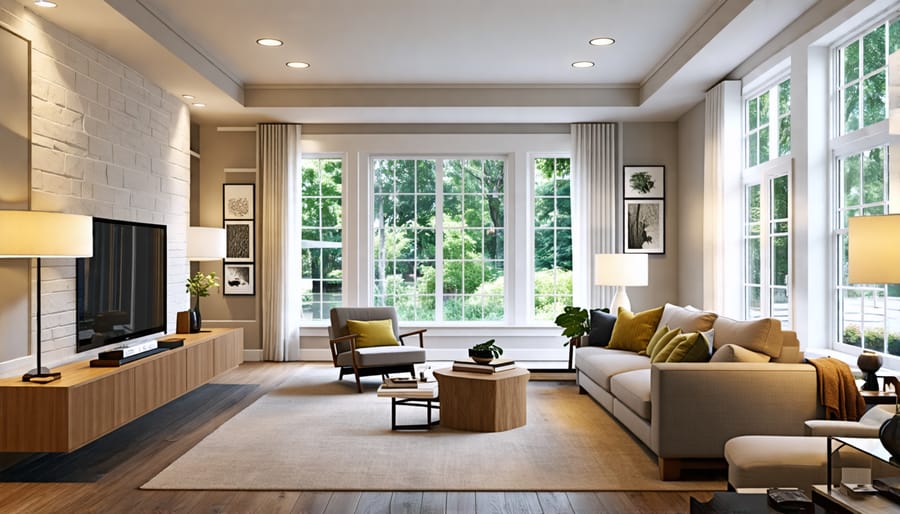Discover the power of intelligent lighting with Lutron lighting control systems. These cutting-edge solutions offer unparalleled flexibility, energy efficiency, and convenience for any space. Explore the benefits of Lutron lighting control and transform the way you experience light:
• Seamless Integration: Lutron systems seamlessly integrate with your existing lighting fixtures, shades, and smart home devices, allowing you to create a cohesive and responsive lighting environment.
• Personalized Control: With intuitive interfaces and customizable scenes, Lutron empowers you to tailor your lighting to suit any mood, task, or occasion, all at the touch of a button.
• Energy Efficiency: Advanced dimming capabilities and daylight sensing optimize energy usage, reducing costs while maintaining the perfect ambiance in your space.
Elevate your lighting experience with Lutron and unlock a world of possibilities. Download our comprehensive PDF guide to learn more about designing, installing, and troubleshooting your Lutron lighting control system.

Components of a Lutron Lighting Control System
Dimmers, Switches, and Keypads
Lutron offers a wide range of dimmers, switches, and keypads to control your lighting system. Dimmers allow you to adjust the brightness of your lights, creating the perfect ambiance for any occasion. Choose from various styles, including sliding, rotary, and tap-button dimmers. Switches provide simple on/off control for lights that don’t require dimming. Lutron’s switches come in different designs to match your decor. Keypads offer customizable control of multiple lights and shades from a single location. You can create personalized scenes, such as “Movie Night” or “Entertaining,” and activate them with the touch of a button. Lutron’s Palladiom keypads feature sleek, minimalist designs that blend seamlessly with your interior. All of these control devices are available in wired and wireless options, making it easy to integrate them into your existing electrical system or create a new one from scratch.

Sensors and Modules
Lutron lighting control systems offer a range of sensors and modules to enhance energy efficiency and user experience. Occupancy sensors detect the presence of people in a room and automatically turn lights on or off, saving energy when spaces are unoccupied. Daylight sensors measure the amount of natural light in a room and adjust artificial lighting accordingly, reducing energy consumption and maintaining optimal lighting levels. Control modules, such as dimming and switching modules, allow for precise control over individual lights or groups of lights, enabling users to create customized lighting scenes for various activities or moods. These sensors and modules seamlessly integrate with Lutron’s centralized control systems, providing a comprehensive and user-friendly lighting management solution for both residential and commercial spaces. By incorporating these advanced components, Lutron systems offer unparalleled energy savings, convenience, and flexibility in lighting control.
Integration with Other Systems
Lutron lighting control systems seamlessly integrate with popular smart home systems, such as Amazon Alexa, Google Assistant, and Apple HomeKit, allowing users to control their lights with voice commands or through their preferred smart home app. Additionally, Lutron systems can be integrated with audio-visual equipment, enabling coordinated control of lighting and media for an immersive home entertainment experience. Lutron also offers integration with HVAC systems, allowing for automated energy-saving adjustments based on room occupancy and time of day. These integrations provide a truly connected and convenient home automation experience, making Lutron a top choice for those seeking a comprehensive smart home solution.
Designing a Lutron Lighting Control System
Assessing Lighting Needs
Assessing your space’s lighting needs is crucial when considering a Lutron lighting control system. Begin by evaluating the room’s size, layout, and natural light sources. Consider the tasks performed in each area and the desired ambiance. For example, a home office may require bright, focused lighting, while a living room benefits from softer, adjustable options. Take note of any architectural features or obstacles that could impact light distribution. Determine the types of fixtures needed, such as recessed lights, pendants, or table lamps, and their ideal placement. Factor in energy efficiency and any specific requirements, like dimming capabilities or color temperature control. Consulting with a lighting professional can help ensure your lighting needs are met effectively. By thoroughly assessing your space, you can create a customized Lutron system that enhances functionality, comfort, and aesthetics.
Device Selection and Placement
Selecting the right Lutron devices and strategically placing them in your space is crucial for achieving optimal lighting control. Consider the room’s size, layout, and functionality when choosing between Lutron’s wide range of dimmers, switches, sensors, and keypads. For example, Pico wireless remote controls are perfect for bedside tables or coffee tables, while Maestro dimmers work well in high-traffic areas like hallways or living rooms.
When positioning devices, think about convenience and accessibility. Place wall-mounted controls at a comfortable height near room entrances, and consider using Lutron’s Claro or Satin Colors wallplates for a sleek, cohesive look. In kitchens, under cabinet lighting paired with a Lutron dimmer adds both function and ambiance.
For larger spaces or those with unique lighting needs, Lutron’s Radio Powr Savr occupancy/vacancy sensors ensure lights are only on when needed, saving energy and adding convenience. Sensors can be ceiling-mounted, corner-mounted, or even integrated into light fixtures. With thoughtful device selection and placement, your Lutron system will provide seamless, intuitive control tailored to your space and needs.
Programming Scenes and Schedules
The Lutron lighting control system allows users to create customized scenes and schedules for their space. With the intuitive software, you can easily program different lighting scenarios for various occasions or times of day. For example, set a “morning” scene that gradually brightens the lights to help you wake up naturally, or create an “evening” scene with dimmed lights for a cozy atmosphere. You can also schedule lights to turn on and off automatically based on your daily routines or events, such as having the lights turn off when you leave for work and turn back on just before you return home. The system’s flexibility enables you to create the perfect ambiance for any situation while also saving energy by ensuring lights are only on when needed. With a few simple steps, you can transform your space and elevate your lighting experience to new heights.
Installing and Setting Up a Lutron System
Wiring and Mounting Devices
When wiring and mounting Lutron devices, it’s essential to follow proper installation techniques to ensure optimal performance and safety. Start by carefully reading the installation instructions provided with each device. Make sure to turn off power at the circuit breaker before beginning any electrical work. Use appropriate wire connectors and properly strip and connect wires according to local electrical codes. Securely mount devices to the wall or ceiling using the included hardware, ensuring they are level and flush with the surface. For larger systems, consider using a Lutron-certified installer to guarantee proper wiring and configuration. Pay close attention to the placement of sensors and keypads, as their location can impact the effectiveness of the lighting control system. Regularly inspect connections and mountings to maintain the integrity and reliability of the Lutron system over time. By adhering to these guidelines, homeowners and professionals can enjoy the full benefits of a well-installed Lutron lighting control solution.

Connecting to the Lutron App
To connect your Lutron devices to the app, start by downloading the Lutron app on your smartphone or tablet. Once installed, open the app and create an account. Next, ensure your Lutron devices are powered on and within range of your mobile device. In the app, select “Add Device” and follow the step-by-step instructions to pair each Lutron component with the app. The process typically involves pressing a button on the device and confirming the connection within the app. After pairing, you can customize settings, create scenes, and control your Lutron lighting system directly from the app interface.
Fine-Tuning and Troubleshooting
When fine-tuning your Lutron lighting control system, start by adjusting the fade time and delay settings to achieve the desired ambiance. If you encounter issues like lights not responding or turning on/off unexpectedly, first check that all connections are secure and batteries are fresh. Ensure the system is properly programmed and that devices are within range. If problems persist, consult the troubleshooting guide in your manual or reach out to Lutron’s support team for assistance. Regular maintenance, such as cleaning sensors and replacing bulbs, can prevent common issues and keep your system running smoothly.
Conclusion
The Lutron lighting control system PDF guide is an invaluable resource for anyone looking to enhance their space with sophisticated, energy-efficient lighting solutions. By providing detailed information on the components, design, installation, and troubleshooting of Lutron systems, this guide empowers homeowners, interior designers, architects, event planners, and commercial business owners to make informed decisions and achieve their desired lighting outcomes.
Throughout this article, we have explored the key features and benefits of Lutron lighting control systems, including their adaptability, ease of use, and potential for energy savings. We have also delved into the various components that make up these systems, such as dimmers, sensors, and smart controllers, and how they work together to create a seamless, personalized lighting experience.
By following the step-by-step instructions and expert tips provided in the Lutron lighting control system PDF guide, you can confidently design and install a system that meets your unique needs and preferences. Whether you are looking to create ambiance in your home, improve productivity in your workplace, or enhance the overall aesthetics of your space, a Lutron system can help you achieve your goals while also reducing your energy consumption and costs.
Resources
For more detailed information on Lutron lighting control systems, refer to the official Lutron HomeWorks QS Programming Guide, which provides comprehensive instructions on system setup and configuration. The Lutron Energy Brochure highlights the energy-saving benefits of their lighting control solutions. If you need further assistance, the Lutron Technical Support page offers various resources, including product manuals, FAQs, and contact information for their expert support team. Additionally, the Lutron Control Institute provides training courses for professionals looking to expand their knowledge of Lutron systems and become certified installers.





